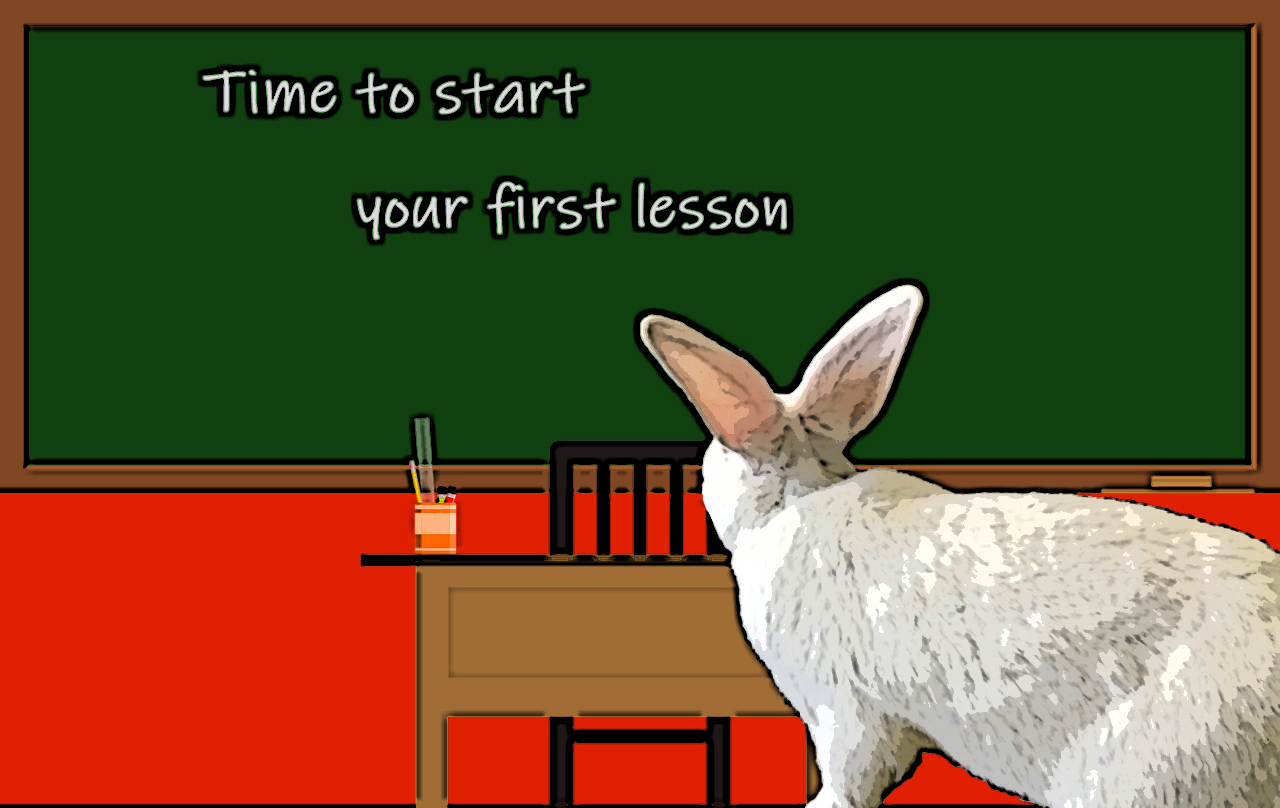
Yes, you can train your rabbit! Want to try? I’ll get you from zero to training in three steps! Ready?
Step 1: The Treats
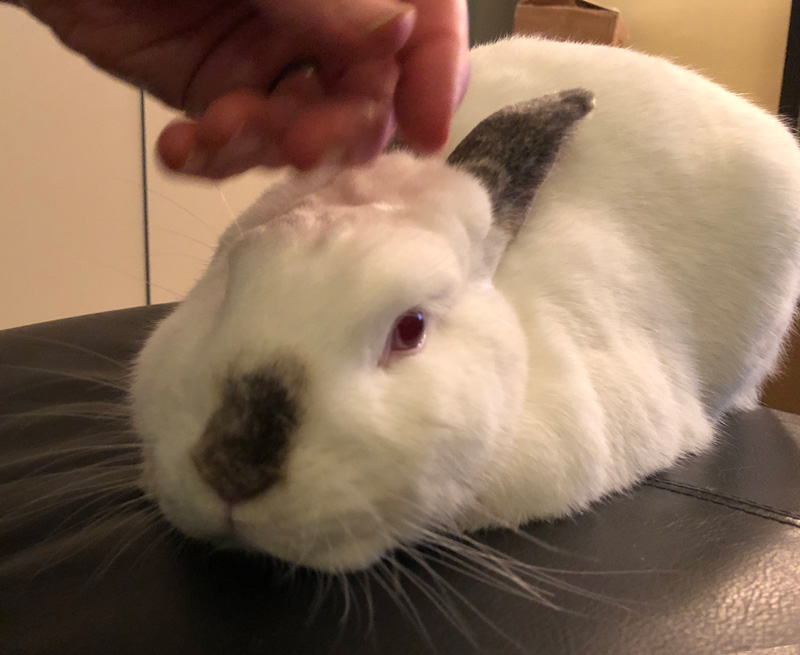
The first thing you need is some “reinforcers.” That simply means something your bunny is willing to work for, i.e, a treat. Some rabbits, like my sweet girl Moraea, will work for pets. But any animal who is not overfed will fancy some snack or other. If you think your bun won’t work for anything, you just haven’t found the right thing yet.
Ideally you should use treats that are not bad for your little sweet-toothed friend. The best way is to use your rabbit’s daily ration of pellet food as his training treats. There are some great bonuses to this strategy:
- You don’t have to worry about any health issues resulting from giving too many sweet treats.
- It encourages you to train every day. That means you’ll make steady progress, and Sir HopsALot will get mental stimulation and quality time with you on a daily basis.
- Rabbit cereal (aka pellets) already comes in small pieces so there’s no prep involved.
While I highly recommend regular cereal, it’s not the only option. Regardless of what you use you’ll want a variety of treats on hand.
Lots of online shops sell rabbit treats that are safe to give in moderation. One handy example is oat groats, or whole oats which are quite small already. For prepared treats, I’ll take a cookie about one inch in diameter and break it up into at least 8-12 small pieces. To get small pieces from these hard, crumbly nuggets, I’ve found a pill cutter can be handy,
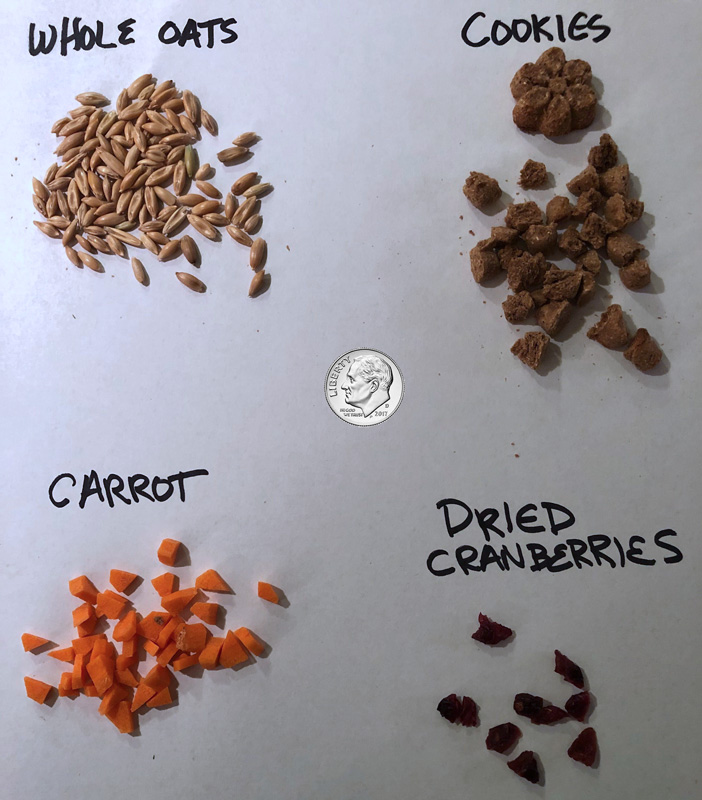 Fruit or carrots can also be used, sparingly, and should be chopped up small. When using dried cranberries I typically get at least 3 treats per cranberry, or more depending on how big the cranberry was.
Fruit or carrots can also be used, sparingly, and should be chopped up small. When using dried cranberries I typically get at least 3 treats per cranberry, or more depending on how big the cranberry was.
Why are small pieces important?
A couple of reasons:
- More treats for the same amount of food.
- Faster training.
Getting treats is fun! The less delay between treats the more excited your learner will be. Chewing time slows things down. Lots of fast action in a short span of time is a great way to build momentum and accelerate learning. Since you have to limit the total amount of treats you hand out, for health reasons, small pieces work best.
If you haven’t already, test out your treats on a hungry pupil ahead of time. If you’re not getting much enthusiasm for a food, it probably won’t work for training. (If your test subject isn’t hungry, you probably won’t get much enthusiasm period!) Of course if you are feeding your bun pellets every day for free, you’ll probably get reduced interest on those. This will change as you fade out the “free” pellets and start only giving them for training.
Make a note of the snacks that get your bunny really excited. You’ll keep those in reserve for tougher training tasks.
Think of it this way. How much would you expect to be paid to walk across the room and bring back a piece of paper vs how much to walk a mile and carry back a box full of books? The rabbit’s not going to be carrying boxes of books, but the point is sometimes you ask for easy stuff, and other times your request is a bigger challenge. If you don’t provide an extra incentive your trainee will soon hop away in a huff and go lay down. That’s what Moraea does in this video when I’ve challenged her too much on a training task.
Be sure to monitor the total amount of goodies you are handing out when you train. Measuring is a good idea. Some rabbits have sensitive tummies that can get gummed up by too much sweet food. Others just plain get fat. While everyone loves a chubby bunny, just as with humans it’s not great for their overall health.
Step 2: The Marker
It really helps to have some way to signal to your bunny that she has done what you want. This signal is called a marker. The best sort of marker is a crisp sound that you won’t accidentally make at times when she’s not doing something you want.
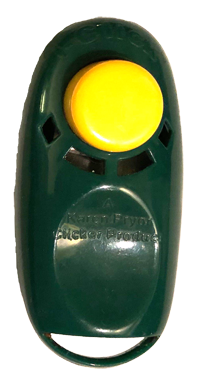 The most common marker used in training is a clicker. Clickers can be purchased online or in pet stores. They’re inexpensive, and the click sound they make is perfect for training. With a rabbit, look for a clicker that is designed to be less loud. (There are some that are designed for this specifically, and they will say so). Obviously your trainee has got the equipment she needs to pick up sound; she doesn’t need amplification. A loud noise might frighten some rabbits.
The most common marker used in training is a clicker. Clickers can be purchased online or in pet stores. They’re inexpensive, and the click sound they make is perfect for training. With a rabbit, look for a clicker that is designed to be less loud. (There are some that are designed for this specifically, and they will say so). Obviously your trainee has got the equipment she needs to pick up sound; she doesn’t need amplification. A loud noise might frighten some rabbits.
While clickers work really well, you don’t absolutely need to use one. You can make any noise you want, so long as you are very consistent about what it is.
I volunteered training dogs at a local shelter where they recommended using “yes” as the marker. “Yes” is something that most people can remember, so they probably get pretty good consistency across volunteers.
Unfortunately, I discovered that I was constantly saying “yeah” or “yes” to dogs. It’s part of the constant one-sided verbal soup that I tend to spew when I see an adorable creature I want desperately to connect with. It was very hard not to mark all sorts of behaviors accidentally! A cheery-sounding nonsense word works better for me as a verbal marker.
The point is, you should choose a marker noise that you think you can remember to emit right at the magical moment when you see the behavior you’re looking for. Make up your mind what it will be and practice it before you begin. For the sake of brevity I’m going to refer to making your marker noise as “clicking” from here onwards.
Step 3: “Priming the Clicker”
Priming the clicker simply means teaching your bunny that a click means a treat. To do this, choose a time when your rabbit will be more interested in you than, say, sleeping. For bunnies, this is usually morning or evening, not the middle of the day, and not immediately after a meal. Get some treats, your clicker (if you’re using one) and your rabbit all in one place, Then just start clicking and immediately delivering a treat after you click. Do this 5-10 times in a row. You can do it a few times a day if you’re motivated to. The more you do it, the sooner you’ll notice your pupil start to look expectantly for the coming treat as soon as you click. When this happens, the clicker is primed.
Some trainers will tell you that it is necessary to “prime the clicker” before you can train. The truth is that if your click-treat timing is good, your rabbit will get the idea pretty fast. But it doesn’t hurt to do it. Be very mindful of when you click, and get that treat delivered promptly – as quickly as possible after the click.
Establishing a strong association between the click and the treat before your start training a behavior will also help cover for beginner mistakes that everyone makes, like the ones I have made many times:
- forgetting to click
- clicking too late
- giving the treat before or concurrently with the click
- groping around for a treat after the click and not delivering it fast enough
So use this as an opportunity to hone your technique before you start working on a specific behavior. Meanwhile your student is learning about clicking. So guess what – you’re training!
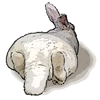 The Fluffy Tail of This Blog Post
The Fluffy Tail of This Blog Post
The first three steps in training are to get some treats ready to go, decide on a marker to use, and practice your click-treat timing. Once you’ve done all that, you can move on to train a specific behavior. I’ll cover that in the next post.